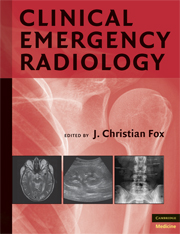Book contents
- Frontmatter
- Contents
- Contributors
- PART I PLAIN RADIOGRAPHY
- PART II ULTRASOUND
- 12 Introduction to Bedside Ultrasound
- 13 Physics of Ultrasound
- 14 Biliary Ultrasound
- 15 Trauma Ultrasound
- 16 Deep Venous Thrombosis
- 17 Cardiac Ultrasound
- 18 Emergency Ultrasonography of the Kidneys and Urinary Tract
- 19 Ultrasonography of the Abdominal Aorta
- 20 Ultrasound-Guided Procedures
- 21 Abdominal—Pelvic Ultrasound
- 22 Ocular Ultrasound
- 23 Testicular Ultrasound
- 24 Abdominal Ultrasound
- 25 Emergency Musculoskeletal Ultrasound
- 26 Soft Tissue Ultrasound
- 27 Ultrasound in Resuscitation
- PART III COMPUTED TOMOGRAPHY
- PART IV MAGNETIC RESONANCE IMAGING
- Index
- Plate Section
14 - Biliary Ultrasound
from PART II - ULTRASOUND
Published online by Cambridge University Press: 07 December 2009
- Frontmatter
- Contents
- Contributors
- PART I PLAIN RADIOGRAPHY
- PART II ULTRASOUND
- 12 Introduction to Bedside Ultrasound
- 13 Physics of Ultrasound
- 14 Biliary Ultrasound
- 15 Trauma Ultrasound
- 16 Deep Venous Thrombosis
- 17 Cardiac Ultrasound
- 18 Emergency Ultrasonography of the Kidneys and Urinary Tract
- 19 Ultrasonography of the Abdominal Aorta
- 20 Ultrasound-Guided Procedures
- 21 Abdominal—Pelvic Ultrasound
- 22 Ocular Ultrasound
- 23 Testicular Ultrasound
- 24 Abdominal Ultrasound
- 25 Emergency Musculoskeletal Ultrasound
- 26 Soft Tissue Ultrasound
- 27 Ultrasound in Resuscitation
- PART III COMPUTED TOMOGRAPHY
- PART IV MAGNETIC RESONANCE IMAGING
- Index
- Plate Section
Summary
INDICATIONS
Biliary ultrasound is part of any complete abdominal ultrasound and limited right upper quadrant ultrasound. A limited right upper quadrant ultrasound will generally image the liver, gallbladder, biliary ducts, and pancreas. The most common indication for ordering a right upper quadrant ultrasound from the ED is right upper quadrant or epigastric pain. Biliary pathology is the most common cause of abdominal pain presenting to the ED in patients older than age 50 years (1). It can present with pain and tenderness that is diffuse and poorly localized, or in locations other than the right upper quadrant. Biliary ultrasound may be indicated in these patients if other studies are negative or suggest right upper quadrant pathology.
Further indications for right upper quadrant ultrasound include newly elevated liver enzymes, hyperbilirubinemia, and hyperlipasemia without a known cause. Unexplained fever in the critically ill patient requires ultrasound of the biliary system to rule out acalculous cholecystitis. Many parasitic infections can lead to liver abscess development or biliary pathology, and ultrasound can be used for diagnostic purposes. Finally, ultrasound is used to direct drainage procedures such as cholecystostomies, abscess drainage, and biopsies.
DIAGNOSTIC CAPABILITIES
Right upper quadrant ultrasound is the initial imaging modality to diagnose biliary disease in the ED.
Keywords
- Type
- Chapter
- Information
- Clinical Emergency Radiology , pp. 218 - 235Publisher: Cambridge University PressPrint publication year: 2008

